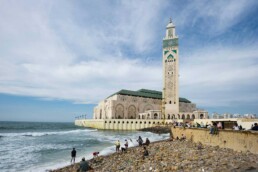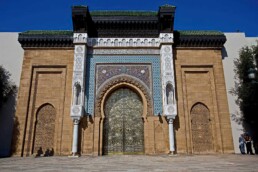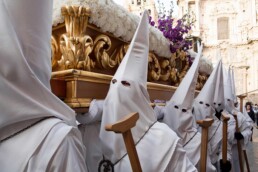The story begins with a whisper from the Atlantic Ocean. Casablanca, also known as “Dar El Beida” in Arabic, is more than just a metropolis; it is a patchwork of histories, cultures, and aspirations, blending colonial beauty with traditional Moroccan charm. As you travel around its bustling streets, you get a strange sense of déjà vu, as if the city itself is a story you’ve heard before but still harbours secrets waiting to be discovered. And why not? Casablanca has stood silently witness to centuries of trade, conquest, celebration, and metamorphosis, turning it into the dynamic metropolis we see today—a city that dares to dream while carrying the weight of history on its shoulders.
The first indications of Casablanca’s roots date back to the 7th century BC, when the Berber tribe created a settlement called “Anfa.” For ages, it served as an important harbour, thriving with trade. Moving forward to the 15th century, the Portuguese seized Anfa and renamed it “Casabranca,” only to abandon it after disastrous wars. The name “Casablanca” is thought to have originated from Portuguese occupation and was later adopted by Spanish traders.
Casablanca became a French protectorate in 1907, marking a watershed moment in its evolution from a tiny fishing town to Morocco’s economic powerhouse. The city’s architecture and urban planning reflect a strong French influence. However, it was not always quiet; one of the most defining moments occurred during World War II, when Casablanca hosted the famous Casablanca Conference in 1943, at which Winston Churchill and Franklin D. Roosevelt gathered to plan the Allied invasion of Europe.
In modern history, Casablanca is Morocco’s largest metropolis and financial centre. Despite the skyscrapers and avenues of international business, vestiges of its complex past remain, making it one of Morocco’s most fascinating cities for both travellers and history buffs.
Imagine yourself at the crossroads of tradition and modernity. Casablanca provides an experience that differs from other “touristy” Moroccan destinations such as Marrakech and Fes. It immerses you in Morocco’s urban atmosphere while still preserving architectural beauty and historical value. Here are some must-see sites to discover Casablanca’s unique flavour.
Hassan II Mosque, A Masterpiece Rising from the Atlantic
The Hassan II Mosque, a wonder of Islamic design and one of the world’s largest mosques, dominates the metropolitan skyline. With its complex zellige tiles, soaring 210-meter minaret, and the Atlantic Ocean lapping at its base, this mosque wonderfully represents the city’s spirit—grand, ambitious, and strongly connected to its surroundings. This is more than just a place of worship; it is a massive symbol of Morocco’s meticulous workmanship, with the capacity to accommodate 25,000 worshippers within and an extra 80,000 in the courtyards.
Old Medina: Touch of Nostalgia
Step through the small, winding lanes of Casablanca’s Old Medina, where the city’s ancestral pulse can still be felt. While smaller and less ornate than medinas in towns such as Marrakech, the historic Medina elicits nostalgia with its modest souks, historic walls, and genuine connection to Casablanca’s pre-modern heritage.
Art Deco Streets in Downtown Casablanca
Stepping from the antique to the grandeur of the twentieth century, you’ll come across Casablanca’s beautiful Art Deco architecture, which distinguishes it. Neighbourhoods like Boulevard Mohammed V and Place des Nations Unies, which were built during the French colonial period, are full of outstanding examples of Art Deco structures with Moroccan characteristics. Cool geometries meet complex mosaics, creating a style that is unmistakably “Casablancan.”
The Royal Palace of Casablanca and the Habous Quarter
The Habous Quarter, commonly known as the New Medina, is a masterpiece of urban architecture built during the French Protectorate. Consider it a reimagining of traditional Moroccan architecture in a more structured, almost grid-like design. The Royal Palace is nearby, and while admission is prohibited, the exteriors and surrounding gardens radiate imperial splendour and are a must-see for any photography aficionado.
Rick’s Café: Iconic for Film Fans
Of course, one cannot visit Casablanca without paying homage to Hollywood. While most people are familiar with the city from the 1942 classic “Casablanca”, the film was actually shot in the United States. Nonetheless, Rick’s Café, a replica of the film’s iconic locale, provides guests with a romanticised retreat into cinema reminiscence, complete with live jazz music.
Casablanca is more than just a destination; it’s a celebration of contrasts. It is a city full of grit and glamour, where centuries-old traditions meet the pace of modernity. Aside from its ancient landmarks and contemporary attractions, Casablanca’s inhabitants may surprise visitors the most. Whether it’s the aroma of freshly baked msemen on a street corner or the joy of youngsters playing football on the Corniche, the city’s human heartbeat is as alive and memorable as its architectural marvels.
For visitors looking to discover a Morocco beyond colourful medinas and desert visions, Casablanca provides a real slice of metropolitan life, complete with successes and contrasts. This is more than a city; it is an invitation to delve deeper, to discover the layers of a metropolis that has divided time into interesting bits of old, new, and everything in between.



